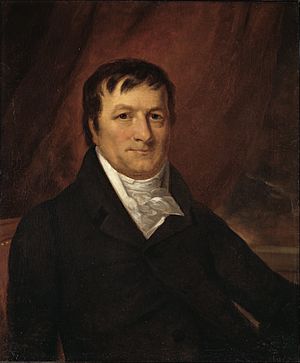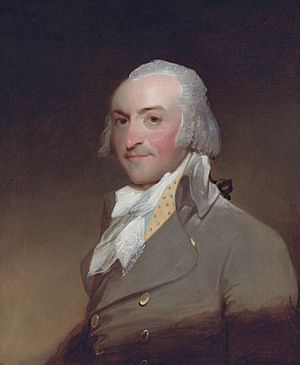John Jacob Astor facts for kids
Quick facts for kids
John Jacob Astor
|
|
|---|---|

John Jacob Astor portrait by John Wesley Jarvis, around 1825
|
|
| Born |
Johann Jakob Astor
July 17, 1763 Walldorf, Electoral Palatinate, Holy Roman Empire
|
| Died | March 29, 1848 (aged 84) New York City, U.S.
|
| Burial place | Trinity Church Cemetery |
| Nationality | German American |
| Occupation |
|
| Known for | First multi-millionaire businessman in the United States |
| Spouse(s) |
Sarah Cox Todd
(m. 1785; died 1842) |
| Children | 8, including William |
| Relatives | See Astor family |
| Signature | |
John Jacob Astor (born Johann Jakob Astor; July 17, 1763 – March 29, 1848) was a very successful German-American businessman. He made most of his money by trading furs and investing in land in and around New York City. He was the first famous member of the Astor family and the first person in the United States to become a multi-millionaire.
Astor was born in Germany and moved to England as a teenager. There, he worked making musical instruments. After the American Revolutionary War, he moved to the United States. He saw that many people were moving west, so he started a fur trading business. He built a huge business empire that reached from the Great Lakes region to the Pacific coast.
By 1830, people's tastes in Europe were changing, so the demand for furs went down. Astor wisely left the fur trade and put his money into real estate in New York City. He became very rich and supported artists. Compared to the total value of goods and services produced in the country (GDP), he was one of the richest people in modern history.
Contents
Biography
Early Life and Moving to America
Johann Jakob Astor was born in 1763 in Walldorf, a town near Heidelberg in Germany. He was the youngest of four sons. As a child, he worked in his father's butcher shop and sold dairy products.
In 1779, when he was 16, he moved to London. He joined his brother George to work for their uncle, who made pianos and flutes. While in London, he learned English and changed his name to John Jacob Astor.
Starting a New Life in the United States
In November 1783, right after the American Revolutionary War ended, Astor sailed to the United States. He arrived in Baltimore around March of the next year. He rented a room from a widow named Sarah Cox Todd. He soon fell in love with her daughter, who was also named Sarah Cox Todd. They got married in 1785.
Astor had planned to join his brother Henry, who had a butcher shop in New York City. However, during his trip, he met a fur trader. This meeting inspired him to join the North American fur trade. After working at his brother's shop for a while, Astor started buying raw animal hides from Native Americans. He prepared the furs himself and then sold them in London and other places for a lot of money. In the late 1780s, he opened his own fur shop in New York. He also worked as the New York agent for his uncle's musical instrument business.
Building a Fortune in Fur Trade

Astor took advantage of the Jay Treaty in 1794. This agreement between Great Britain and the United States opened new markets in Canada and the Great Lakes region. Astor quickly made a deal with the North West Company in Montreal, which was a rival to the Hudson's Bay Company.
Astor brought furs from Montreal to New York and then shipped them to Europe. By 1800, he had saved almost a quarter of a million dollars. This amount would be worth six million dollars today (in 2020). He became one of the most important people in the fur trade. His agents worked all over the western areas and were very tough competitors. In 1800, Astor also started trading furs, teas, and sandalwood with Canton in China. He made a huge profit from this trade.
However, the U.S. Embargo Act of 1807 stopped Astor's import and export business because it closed off trade with Canada. With permission from President Thomas Jefferson, Astor started the American Fur Company on April 6, 1808. He later created other companies, like the Pacific Fur Company, to control fur trading in the Great Lakes and Columbia River areas. His trading post at Fort Astoria (started in April 1811) was the first U.S. community on the Pacific coast. He also paid for the Astor Expedition in 1810–1812 to reach this outpost by land. Members of this expedition discovered South Pass, a route through the Rocky Mountains that hundreds of thousands of settlers later used on trails like the Oregon Trail.
Astor's fur trading was interrupted during the War of 1812, when the British took over his trading posts. But his business bounced back in 1817. This happened after the U.S. Congress passed a law that stopped foreign fur traders from working in U.S. territories. The American Fur Company then became the main fur trading company around the Great Lakes, taking over its rivals.
In 1822, Astor set up the Robert Stuart House on Mackinac Island in Michigan. This became the main office for the American Fur Company, making the island a busy center for fur trade. The writer Washington Irving wrote a lot about this in his book Astoria. Astor's business connections reached all over the world, and his ships were in every sea.
Investing in Real Estate and Retirement
Astor started buying land in New York City in 1799. He bought a lot of property along the waterfront. After 1800, with profits from his China trade, he became even more focused on investing in New York real estate. In 1803, he bought a 70-acre farm where he built the Astor Mansion. This property stretched from Broadway to the Hudson River, between 42nd and 46th streets. In the same year and the next, he bought a lot of land from Aaron Burr.
In the 1830s, Astor realized that New York City was going to grow very fast and become one of the world's greatest cities. So, Astor sold his shares in the American Fur Company and all his other businesses. He used that money to buy and develop large areas of land in Manhattan. Astor correctly predicted that the city would grow quickly northward on Manhattan Island. He bought more and more land beyond the city limits at that time. Astor rarely built on his land himself. Instead, he leased it to others for rent and their use.
After retiring from his businesses, Astor spent the rest of his life supporting culture. He helped the bird expert John James Audubon with his studies, artwork, and travels. He also supported the presidential campaign of Henry Clay.
Marriage and Family Life
On September 19, 1785, Astor married Sarah Cox Todd (born April 9, 1762 – died August 3, 1842). Her parents were Scottish immigrants. Even though she only brought him $300 as a dowry (money or property a bride brings to a marriage), she was very good with money. Astor said her business judgment was better than most merchants. She helped him with the practical parts of his business and managed his affairs when he was away from New York.
They had eight children:
- Magdalena Astor (1788–1832)
- Sarah Todd Astor (1790–1790), who was stillborn (born not alive).
- John Jacob Astor Jr. (1791–1869), who was often sick and had mental health issues.
- William Backhouse Astor Sr. (1792–1875), who continued the family business.
- Dorothea Astor (1795–1874)
- Henry Astor II (1797–1799), who died as a child.
- Eliza Astor (1801–1838)
- An unnamed son (1802–1802), who died a few days after birth.
Community Involvement
Astor was a member of the Freemasons, which is a fraternal (brotherhood) organization. He was the Master of Holland Lodge #8 in New York City in 1788. Later, he served as the Grand Treasurer for the Grand Lodge of New York. He was also the president of the German Society of the City of New York from 1837 to 1841.
Legacy and Impact
When John Jacob Astor died in 1848, he was the richest person in the United States. His fortune was estimated to be at least $20 million. This was about 0.9% of the total value of goods and services produced in the U.S. at that time. To compare, this is similar to the wealth of Jeff Bezos in 2020, which was about $200 billion, also around 0.9% of the U.S. GDP.
In his will, Astor left $400,000 to build the Astor Library for the public in New York. This library later joined with other libraries to form the famous New York Public Library. He also left $50,000 for a poorhouse (a place for poor people) and an orphanage in his German hometown of Walldorf. The Astorhaus building there is now a museum honoring Astor.
Astor left most of his money to his second son, William, because his oldest son, John Jr., was often sick and had mental health issues. Astor made sure John Jr. had enough money to be cared for throughout his life. William continued to grow the family's wealth.
Astor is buried in Trinity Church Cemetery in Manhattan. Even though many of his family members joined that church, Astor remained a member of his local German Reformed Church until he died.
The two marble lions at the entrance of the New York Public Library Main Branch were originally named Leo Astor and Leo Lenox. They were named after Astor and James Lenox, who helped start the library. Later, they were called Lord Astor and Lady Lenox. During the Great Depression, Mayor Fiorello La Guardia renamed them "Patience" and "Fortitude."
Several places are named after Astor:
- The neighborhood of Astoria in Queens, New York City.
- The one-block street called Astor Place in Manhattan, New York City.
- The coastal town of Astoria, Oregon, and an elementary school there. The story of how this town was founded is told in Washington Irving’s book Astoria, which Astor helped pay for.
- The historic Astor Street in Green Bay, Wisconsin. In 1835, John Jacob Astor founded the Town of Astor in Wisconsin.
In 1908, when the association football (soccer) club FC Astoria Walldorf was formed in Astor's birthplace in Germany, they added "Astoria" to their name to honor him and his family.
Images for kids
-
John Jacob Astor, painted by Gilbert Stuart, around 1794
See also
 In Spanish: John Jacob Astor para niños
In Spanish: John Jacob Astor para niños
- Russian-American Company
- Astor family
- Astoria (book)
- Astor Place
- Astor Row
- List of wealthiest historical figures
- List of richest Americans in history
- List of Freemasons
- Waldorf-Astoria Hotel
- Joseph LaBarge – Steamboat captain hired by Astor and the American Fur Company, his primary shipper.



